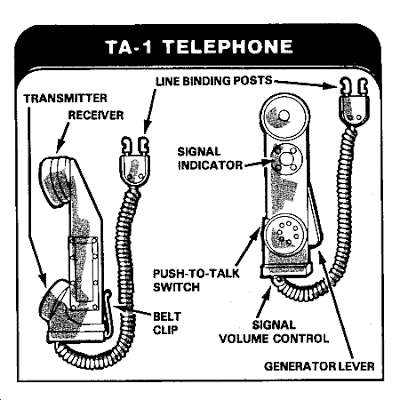
TA-1 sound-powered field telephone.
In response to this post Dr. D has begun a blog on expedient wire communications, writing:
Mike I will gladly volunteer for the "wire coms" discussion as this right up my alley (I've been a phone man for 40 years and built a "magneto ringing" phone set as a teenager and wired it between our summer house and my grandmothers house. I have lot of ideas I'd like to contribute.
Dr.D III
In addition, Anonymous left this comment:
Retired SBC (now AT&T or whatever their name is this month) installer repairman here.
TA-1 & TA-312 communcation is very easy over current copper twisted pair cable. Aerial, or buried, but buried (sometimes) is easier to access.
The hard part is understanding cable color code and binding post methodology so a person can tap the right line. Even multiple sets can be bridged onto the pair and you have your own party line.
Any vacant (you want vacant)serviceable pair will do, all you have to do is figure out if the opposite ends of you talk points are on the same 'leg' of cable, or are on legs that connect through a crossbox.
If not, you have more of a problem than you can solve. That's why they're called central offices.
A few standard telephone tools are really all that's needed. A ohm/megohm meter, a tone generator and a probe to trace pairs. A 'can' wrench to open terminals, and a standard 'buttin' set.
Of course, the easiest way around this is to recruit one of us that's not retired yet onto the team.
The bad thing today is the current trend of 'fiber to the house'. for Uverse service. In newer subdivisions, there is no wire available.
Outstanding! Now we're getting somewhere. For those of you who are unfamiliar with non-state-of-the-art military communications, start here with "Praxis: Commo after The Big Darkness -- Field Telephones" from last year.
1 comment:
Thanks Mike I hope my humble efforts are worthy of your praise.
Dr.D III
Post a Comment